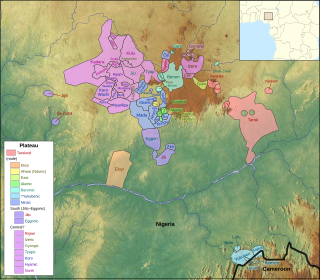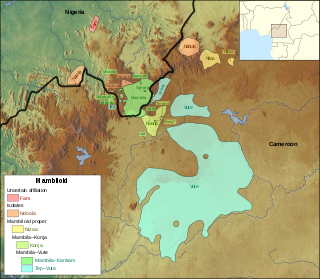Related Research Articles

Niger–Congo is a hypothetical language family spoken over the majority of sub-Saharan Africa. It unites the Mande languages, the Atlantic–Congo languages, and possibly several smaller groups of languages that are difficult to classify. If valid, Niger–Congo would be the world's largest in terms of member languages, the third-largest in terms of speakers, and Africa's largest in terms of geographical area. Austronesian has almost as many member languages, although this is complicated by the ambiguity about what constitutes a distinct language; the number of named Niger–Congo languages listed by Ethnologue is 1,540.
Defaka is an endangered and divergent Nigerian language of uncertain classification. It is spoken in the Opobo–Nkoro LGA of Rivers State, in the Defaka or Afakani ward of Nkọrọ town and Ịwọma Nkọrọ. The low number of Defaka speakers, coupled with the fact that other languages dominate the region where Defaka is spoken, edges the language near extinction on a year-to-year basis. It is generally classified in an Ijoid branch of the Niger–Congo family. However, the Ijoid proposal is problematic. Blench (2012) notes that "Defaka has numerous external cognates and might be an isolate or independent branch of Niger–Congo which has come under Ịjọ influence."

The forty or so Plateau languages are a tentative group of Benue–Congo languages spoken by 15 million people on the Jos Plateau, Southern Kaduna, Nasarawa State and in adjacent areas in central Nigeria.
Cicipu is a Kainji language spoken by about 20,000 people in northwest Nigeria. The people call themselves Acipu, and are called Acipawa in Hausa.

The twelve Mambiloid languages are languages spoken by the Mambila and related peoples mostly in eastern Nigeria and in Cameroon. In Nigeria the largest group is Mambila. In Cameroon the largest group is Vute.
Ukaan is a poorly described Niger–Congo language or dialect cluster of uncertain affiliation. Roger Blench suspects, based on wordlists, that it might be closest to the (East) Benue–Congo languages. Blench (2012) states that "noun-classes and concord make it look Benue-Congo, but evidence is weak."

Kaluli is a language spoken in Papua New Guinea. It is a developing language with 3,100 speakers. Some people refer to this language as Bosavi, however the people themselves refer to the language as Kaluli. There are four dialects, Ologo, Kaluli, Walulu, and Kugenesi. The differences between the dialects are not clear. Their writing system uses the Latin script. Kaluli belongs to the Trans-New Guinea language family. Kaluli was first analyzed by Murray Rule in 1964 who wrote a preliminary phonological and morphological analysis. A dictionary of Kaluli has been compiled by Schieffelin and Feld (1998).
Mambila is a dialect chain stretching across Nigeria and Cameroon. It is one of the Mambiloid languages, a branch of Benue–Congo.
Daka is one of two languages spoken by the Chamba people in Nigeria, the other being Chamba Leko.
Yiwom (Ywom), also known as Gerka or Gerkawa by the Hausa, is a Chadic (Afro-Asiatic) language spoken in Plateau State, Nigeria.
Ahwai, also called the Ndunic languages, is a Plateau language cluster spoken to the southwest of Fadan Karshi in Sanga LGA, Kaduna State, Nigeria. Most villages are located at the foot of the Ahwai Mountains in Kaduna State.
Izere is a dialect continuum of Plateau languages in Nigeria. According to Blench (2008), it is four languages, though Ethnologue does not distinguish NW and NE Izere. The Cen and Ganang varieties are spoken by only 2000 each. Cen has added Berom noun-class prefixes and consonant alternation to an Izere base.
Idun (Idũ), or Dũya, is a poorly attested Plateau language of Nigeria. Its classification is uncertain, but it may be closest to Ashe.
Vute is a Mambiloid language of Cameroon and Gabon, with a thousand speakers in Nigeria. The orthography was standardized on March 9, 1979. Noted dialect clusters are eastern, central, and Doume.
Tep is a Mambiloid language of Nigeria. Ethnologue considers it a dialect of Mambila, as speakers identify as Mambila, but it is a distinct language.
Ndunda is a minor Mambiloid language of Nigeria. It was discovered by Roger Blench near the Mvanip-speaking town of Zongo Ajiya. Ndunda village is situated about 5 kilometers from Yerimaru, to the south of Zongo Ajiya. It is closely related to but distinct from Mvanip.
Njerep (Njerup) is a Mambiloid language spoken in the Adamawa Region of Cameroon. Njerep is essentially extinct, with only 4 people who speak it at home. Though word lists and grammatical information have been collected from these people, the information remains fragmented.
Twendi, or Cambap as it is also known, is a nearly extinct Mambiloid language of Cameroon. Speakers have largely shifted to the closely related language Kwanja, and Twendi has not been passed down to children for decades. The language is spoken in the villages of Cambap and Sanga on the Tikar Plain by no more than 30 people, the youngest of whom were born in the 1940s.
Karang language is an Mbum language of Cameroon and Chad.
Ndola People are found in Taraba, Nigeria and located in Kurmi and Ngada. Few are also found in Cameroon.
References
- ↑ Mvanip at Ethnologue (18th ed., 2015) (subscription required)
- ↑ "Mvanip". Ethnologue. Retrieved 2016-04-29.
- ↑ Voegelin, C. F.; Voegelin, F. M. (1964). "Languages of the World: African Fascicle One". Anthropological Linguistics. 6 (5): 1–339. JSTOR 30022465.
- 1 2 Blench, R. (2012). An atlas of Nigerian languages.
- 1 2 3 Blench, Roger (1993). "An Outline Classification of the Mambiloid Languages" (PDF). Journal of West African Languages.